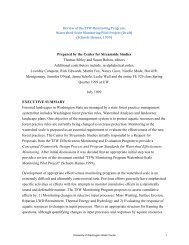Copyright 2012 Aileen M. Echiverri-Cohen - University of Washington
Copyright 2012 Aileen M. Echiverri-Cohen - University of Washington
Copyright 2012 Aileen M. Echiverri-Cohen - University of Washington
Create successful ePaper yourself
Turn your PDF publications into a flip-book with our unique Google optimized e-Paper software.
Giakoumaki, Theou, & Frangou, 2006; Giakoumaki, Bitsios, & Frangou, 2006); whereas, lower<br />
PPI is thought to reflect reduced efficiency in filtering information. Thus, impaired PPI may<br />
reflect a reduced ability to inhibit sensory information, as well as a failure <strong>of</strong> sensorimotor<br />
gating. Accordingly, PPI has been used to study inhibitory deficits across various forms <strong>of</strong><br />
psychopathology (e.g., schizophrenia; Swerdlow, Light, Cadenhead, Sprock, Hsieh, & Braff,<br />
2006; obsessive compulsive disorder; Swerdlow, Benbow, Zisook, Geyer, & Braff, 1993).<br />
The PPI studies in individuals with PTSD are at present equivocal, though there is<br />
general evidence pointing to reduced PPI compared to controls (Grillon, Morgan, Southwick,<br />
Davis, & Charney, 1996; Grillon, Morgan, Davis, & Southwick, 1998; Ornitz & Pynoos, 1989).<br />
Specifically, Grillon et al. (1996) examined PPI in combat veterans with PTSD and found a<br />
lower PPI compared to a no psychopathology control group and a trend toward lower PPI<br />
compared to a trauma-exposed group (Grillon et al., 1996). Reduced PPI in PTSD compared to<br />
controls was replicated in another investigation by the same group (Grillon et al., 1998). In<br />
contrast, two studies (Butler, Braff, Rausch, Jenkins, Sprock, & Geyer, 1990; Morgan, Grillon,<br />
Lubin, & Southwick, 1997) showed no differences in PPI across PTSD and control groups.<br />
However, both studies had notable confounds. Butler et al. (1990) removed 35% <strong>of</strong> the sample<br />
from their analyses based on a conservative criteria for identifying startle non-responders (less<br />
than 120 uV in the 116dB group). Morgan et al.’s study utilized a sample <strong>of</strong> female assault<br />
victims without isolating the effects <strong>of</strong> elevated estrogen, which has been associated with<br />
reduced PPI responding (Swerdlow, Hartman, & Auerbach, 1997). Thus, not controlling for<br />
phase <strong>of</strong> menstrual cycle may have accounted for these negative findings.<br />
AB and PPI are thought to be functionally linked, with AB potentially indicating the<br />
duration <strong>of</strong> inhibition and PPI potentially reflecting the strength <strong>of</strong> inhibition (Cornwell,<br />
10
















